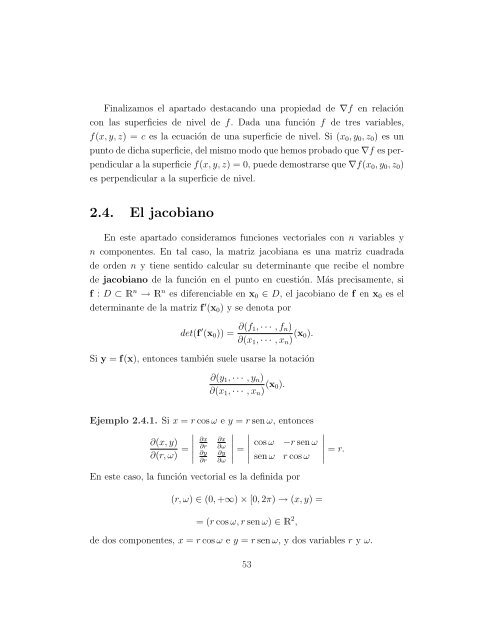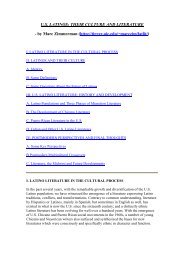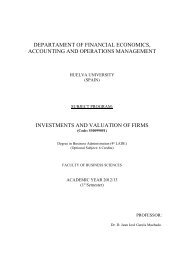2º Regla de la cadena y derivación implícita
2º Regla de la cadena y derivación implícita
2º Regla de la cadena y derivación implícita
You also want an ePaper? Increase the reach of your titles
YUMPU automatically turns print PDFs into web optimized ePapers that Google loves.
Finalizamos el apartado <strong>de</strong>stacando una propiedad <strong>de</strong> ∇f en re<strong>la</strong>ción<br />
con <strong>la</strong>s superficies <strong>de</strong> nivel <strong>de</strong> f. Dada una función f <strong>de</strong> tres variables,<br />
f(x, y, z) = c es <strong>la</strong> ecuación <strong>de</strong> una superficie <strong>de</strong> nivel. Si (x0, y0, z0) es un<br />
punto <strong>de</strong> dicha superficie, <strong>de</strong>l mismo modo que hemos probado que ∇f es per-<br />
pendicu<strong>la</strong>r a <strong>la</strong> superficie f(x, y, z) = 0, pue<strong>de</strong> <strong>de</strong>mostrarse que ∇f(x0, y0, z0)<br />
es perpendicu<strong>la</strong>r a <strong>la</strong> superficie <strong>de</strong> nivel.<br />
2.4. El jacobiano<br />
En este apartado consi<strong>de</strong>ramos funciones vectoriales con n variables y<br />
n componentes. En tal caso, <strong>la</strong> matriz jacobiana es una matriz cuadrada<br />
<strong>de</strong> or<strong>de</strong>n n y tiene sentido calcu<strong>la</strong>r su <strong>de</strong>terminante que recibe el nombre<br />
<strong>de</strong> jacobiano <strong>de</strong> <strong>la</strong> función en el punto en cuestión. Más precisamente, si<br />
f : D ⊂ R n → R n es diferenciable en x0 ∈ D, el jacobiano <strong>de</strong> f en x0 es el<br />
<strong>de</strong>terminante <strong>de</strong> <strong>la</strong> matriz f ′ (x0) y se <strong>de</strong>nota por<br />
<strong>de</strong>t(f ′ (x0)) = ∂(f1, · · · , fn)<br />
∂(x1, · · · , xn) (x0).<br />
Si y = f(x), entonces también suele usarse <strong>la</strong> notación<br />
∂y<br />
∂r<br />
∂(y1, · · · , yn)<br />
∂(x1, · · · , xn) (x0).<br />
Ejemplo 2.4.1. Si x = r cos ω e y = r sen ω, entonces<br />
∂(x, y)<br />
∂(r, ω) =<br />
<br />
<br />
<br />
<br />
<br />
∂x<br />
∂r<br />
∂x<br />
∂ω<br />
<br />
<br />
<br />
<br />
=<br />
<br />
<br />
cos ω<br />
<br />
sen ω<br />
<br />
−r sen ω<br />
<br />
<br />
= r.<br />
r cos ω <br />
∂y<br />
∂ω<br />
En este caso, <strong>la</strong> función vectorial es <strong>la</strong> <strong>de</strong>finida por<br />
(r, ω) ∈ (0, +∞) × [0, 2π) → (x, y) =<br />
= (r cos ω, r sen ω) ∈ R 2 ,<br />
<strong>de</strong> dos componentes, x = r cos ω e y = r sen ω, y dos variables r y ω.<br />
53

















